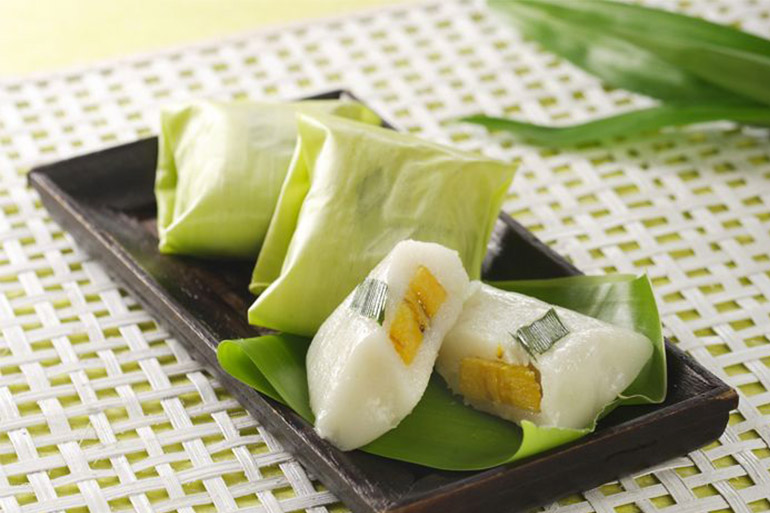Banana is the most widely available in all fruits in Indonesia, it is not surprising that they feature in many desserts and cakes
Ingredients:
6 large ripe banana or 2 small
Rice flour 1 ¼ (150 g)
4 tablespoons flour or tapioca flour, mung bean
2 cups (500 ml) coconut milk diluted
¼ cup (50 g) sugar
A pinch of salt
Twelve 7-in (18 cm) square pieces of banana leaves, packing
Toothpicks to attach
Cooking Directions:
Peel and cut each banana if you use small or large bananas, cut each diagonally into six ½ inch (1 cm) thick, set aside.
Combining the two types of flour and 1 ½ cup (325 ml) coconut milk and mix into a smooth paste abowl and smooth. Set aside.
Mix remaining coconut milk, sugar and salt in a saucepan and heat over medium heat, stirring until sugar dissolves. A boil, pour mixture and cook, stirring constantly until mixture thickens 5 to 10 minutes. Remove from heat and cool
Blanch the banana leaves, pour boiling water over them in a container to be flexible. Drain and place the leaves on a clean work surface.
To finish the cake, spread 2 tablespoons of the flour mixture through the center of a piece of banana on top and then spread to another 2 tablespoons of the flour mixture through the center of a piece of banana leaf. Place a slice of banana bread on top and then spread to another 2 tablespoons of the flour mixture over, covering the bananas. Wrap by folding one side of the banana leaf over the filling and then the other, forming a tight plot. Meta ends under and secure with a toothpick. Continue wrapping the remaining ingredients in this way.
Steam from the plot in a wok on a rack in boiling water or a Stearns for about 20 minutes. Remove from heat and let cool before serving.
Note: mung bean flour (tepong Hoen kWe) is sold in rolls of paper, sometimes the food is pink or green paper packaging and the corresponding color. It gives a more delicate texture to the rice flour desserts, although this is an acceptable substitute
Health Benefits :
Kue nagasari is a traditional Indonesian dessert made from sticky rice flour and coconut milk, filled with slices of ripe banana, and wrapped in banana leaves before steaming. While kue nagasari is primarily enjoyed for its taste and cultural significance, it does offer some potential health benefits:
1. Gluten-free option: Kue nagasari is typically made from sticky rice flour, which is gluten-free. This makes it suitable for individuals with gluten intolerance or celiac disease.
2. Nutrient-rich ingredients: Kue nagasari contains natural ingredients such as coconut milk and ripe bananas. Coconut milk provides healthy fats and essential minerals, while bananas are a good source of vitamins, dietary fiber, and natural sugars.
3. Dietary fiber: Both sticky rice flour and bananas used in kue nagasari are sources of dietary fiber. Fiber aids in digestion, promotes satiety, and helps maintain a healthy digestive system.
4. Vitamin and mineral content: Ripe bananas used in kue nagasari are rich in potassium, vitamin C, vitamin B6, and magnesium. These nutrients are important for various bodily functions, including heart health, immune function, and nerve function.
5. Low in cholesterol and sodium: Kue nagasari is naturally low in cholesterol and sodium, which can be beneficial for individuals aiming to limit their intake of these components.
6. Cultural significance: Enjoying traditional and culturally significant foods like kue nagasari can provide a sense of connection to one's heritage and cultural identity, contributing to overall well-being.
While kue nagasari can be enjoyed as part of a balanced diet, it's important to be mindful of portion sizes and the overall sugar content. Additionally, homemade versions of kue nagasari may allow for better control over the quality and quantity of ingredients used.
